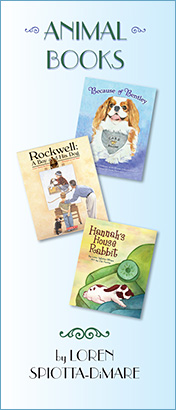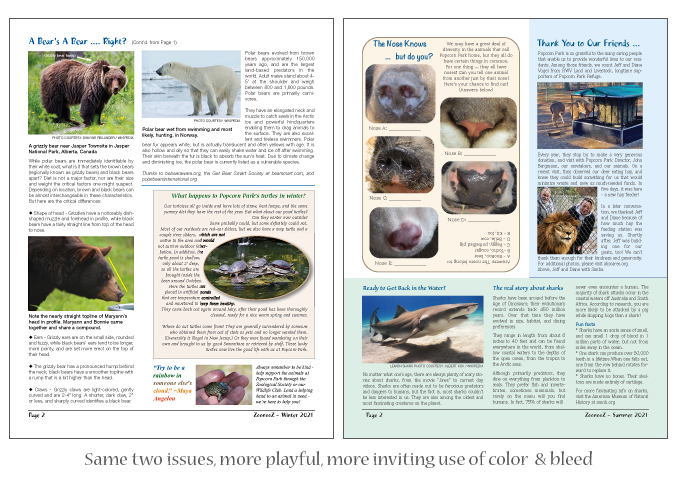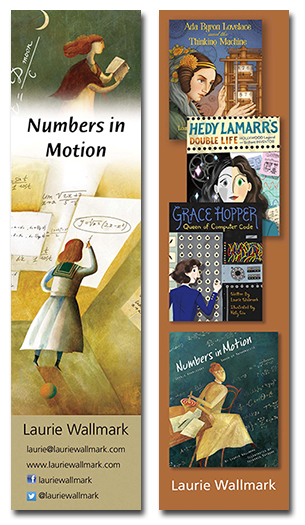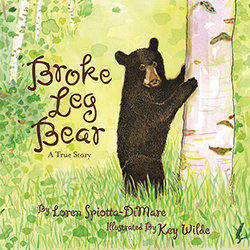 There are plenty of ways to promote yourself as an author, and here’s another one – a brochure. Shown here is a tri-fold brochure which features a selection of animal books that a well-known local author, Loren Spiotta-DiMare, has available – some for adults, most for children. On this particular project, Loren had asked for my help in re-creating the brochure to be similar to her last one. The original designer was unavailable, so I essentially did a new layout, added new books, plus new design elements and fonts. The end product was similar, but clearly new and different.
There are plenty of ways to promote yourself as an author, and here’s another one – a brochure. Shown here is a tri-fold brochure which features a selection of animal books that a well-known local author, Loren Spiotta-DiMare, has available – some for adults, most for children. On this particular project, Loren had asked for my help in re-creating the brochure to be similar to her last one. The original designer was unavailable, so I essentially did a new layout, added new books, plus new design elements and fonts. The end product was similar, but clearly new and different.
I’ve worked with Loren in the past in helping her self-publish, as well as with several other projects, so I was happy to bring something fresh to her brochure. The front is simple and tells you what you’ll find inside. In the center panel of the outside of the brochure we have author information and a photo of Loren with some of her children’s books. On the third fold-in panel, are featured four books for adults.

Inside the brochure, above, you’ll see a fairly comprehensive selection of her children’s books, including short summaries and pricing. In the upper right is an order form.
Brochures like this do assume that you have a good selection of books to offer, but a brochure doesn’t always have to have 3 panels, either. It could have 2 panels, or it could just be one – 1/3 of what you see above – known as a rack card. In a case like that, you could feature your book(s) on the front, and on the back, author information and an order form. Simple.
And … any of these can be made into a PDF and shared by e-mail or be made available for download on your website or social media sites.
Where would you use these? Certainly at events, book festivals, and at, and in advance of, school events for kids. You could have them on display, or if you suspected your audience might want to order more than one title, or in multiples, you might send some on ahead of your visit. In fact, send them to anyone you think might be interested in purchasing your book(s)! While I’m not sure of the policies they must follow, librarians might welcome a small catalog such as this as well. Some of the books featured are self-published, but others have been printed by traditional publishers.
If you want to sell more books, you need to be pro-active, especially if you are self-publishing. When you are published traditionally, a huge amount of publicity is done by the publisher on your behalf, far beyond what the average self-publishing author could ever do. That’s why it’s so important to think of how you can promote yourself! If I can help, let me know.
See more samples of my graphic design work.










 It goes without saying that authors, whether traditionally or self-published, can use this valuable promotional tool and keep themselves in the public’s eye.
It goes without saying that authors, whether traditionally or self-published, can use this valuable promotional tool and keep themselves in the public’s eye. 
 An example here is my own shop on Etsy which focuses on a growing collection of cards and other items for the French Bulldog. Any books? Not a one. But does every sold item I send out have a promotional bookmark tucked in? You bet!
An example here is my own shop on Etsy which focuses on a growing collection of cards and other items for the French Bulldog. Any books? Not a one. But does every sold item I send out have a promotional bookmark tucked in? You bet! Pictured here is a bookmark I designed for the
Pictured here is a bookmark I designed for the 








 They’re light; they’re portable; and easy to save. Business cards really never go out of style, and anyone conducting business of any kind always needs to carry them with them.
They’re light; they’re portable; and easy to save. Business cards really never go out of style, and anyone conducting business of any kind always needs to carry them with them. story of you/your business, and contact information. In my own business card, upper left, you see only the front. The back features another illustration of mine and all my contact information.
story of you/your business, and contact information. In my own business card, upper left, you see only the front. The back features another illustration of mine and all my contact information. Another example of a one-sided card is the one I designed for
Another example of a one-sided card is the one I designed for  There are plenty of ways to promote yourself as an author, and here’s another one – a brochure. Shown here is a tri-fold brochure which features a selection of animal books that a well-known local author,
There are plenty of ways to promote yourself as an author, and here’s another one – a brochure. Shown here is a tri-fold brochure which features a selection of animal books that a well-known local author, 